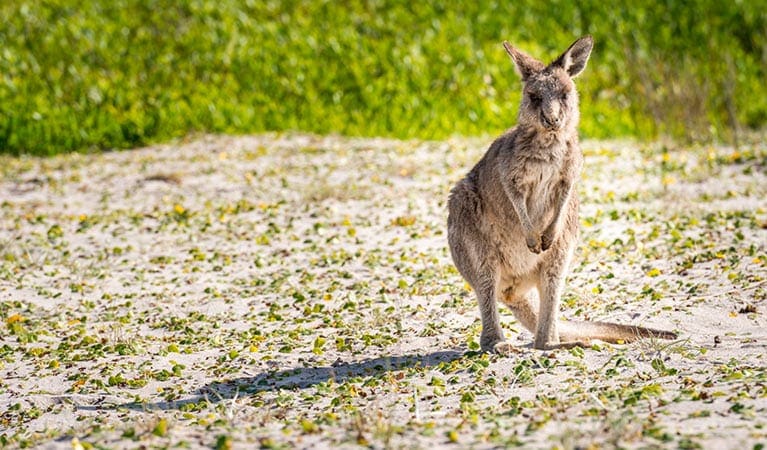Trail Fast Facts
Bittangabee Bay carpark to beach is a 1km, grade 3 hike in Beowa National Park, New South Wales. This hike typically takes 30 minutes to complete.
Hike Overview
This is a short walk onto the lovely sandy Bittangabee Beach. The walk heads down from the car park through the picnic area and onto the beach. There is generally no surf at the beach as it tucked into the bay. The walk is very well signposted and along a well defined track.
Download maps and tracknotes for Bittangabee Bay carpark to beach hiking track from wildwalks.com.
Track Grade
Grade 3 (Moderate) - Walks for Most Fitness Levels: Grade 3 on the AWTGS represents moderate walking tracks. These are ideal for walkers with some fitness who are comfortable with some hills and uneven terrain. While suitable for most ages, some bushwalking experience is recommended to ensure a safe and enjoyable experience. Tracks may have short, steep hill sections, a rough surface, and many steps. The total distance of a Grade 3 walk can be up to 20 kilometers.
Map and GPX file
Max elevation: 26 m
Min elevation: 6 m
Total climbing: 34 m
Total descent: -34 m
Trailhead
Sorry, no records were found. Please adjust your search criteria and try again.
Sorry, unable to load the Maps API.
Photo gallery
If you’ve got some great shots from this hike, I’d love to see them! Please upload your .jpg files here to help inspire other hikers and show off the beauty of the trail.
A quick note: Uploading your photos doesn’t mean you lose ownership. You’ll be credited for any photos you share, and you can request to have them removed at any time.
About the region
Beowa National Park, formerly Ben Boyd National Park, spans 47km of rocky coastline and sheltered inlets. Located near the whale watching town of Eden on the far South Coast of NSW, its crystal clear waters are perfect for snorkelling and swimming.
Beowa National Park is separated into 2 areas, split by Twofold Bay. Take your pick from the sparkling lakes and surf beaches in the park's Pambula-Haycock area to the rocky cliffs and beachside campgrounds in the Green Cape area.
Its spectacular sea-carved landscape is a striking display of folded red rock platforms that contrast against the sapphire blue water of the ocean.
Suggest an edit
Spotted a change on this trail? Maybe there are new features, the route has shifted, or the trail is permanently closed. Whatever the update, I’d love your input. Your feedback helps fellow hikers stay informed and ensures that our trail info stays fresh and reliable.
Similar trails nearby
Looking for things to do in Beowa (Ben Boyd) National Park or nearby? Try these similar hikes or bushwalks.
Let someone know
Adventure with Confidence: Register Your Trip Plans
Before you hit the trail, take a moment to fill out our trip intentions form. It’s a simple way to share important details about your hike with family or friends. If things don’t go as planned and you’re not back on time, they can easily notify emergency services, helping to ensure a quick response and reducing worry. Enjoy your outdoor adventure knowing that you’ve taken a smart step for your safety.
Gear to consider
What you carry in your pack will depend on the weather, terrain, time of year, type of adventure, and personal preferences. Having trouble deciding what gear’s right for you? My free planning, food and packing checklists provide an introduction to things your could consider (as well as the Ten Essentials) on your day, overnight and multi-day adventures. Customise your kit according to your personal needs, always considering safety first.
Explore Safe
While planning your hike, it’s important to check official government sources for updated information, temporary closures and trail access requirements. Before hitting the trail, check local weather and bushfire advice for planned burns and bushfire warnings and let someone know before you go. Plan ahead and hike safely.
Weather
Acknowledgement of Country
Trail Hiking Australia acknowledges the Traditional Owners of the lands on which we hike and pay respects to their Elders, past and present, and we acknowledge the First Nations people of other communities who may be here today.






